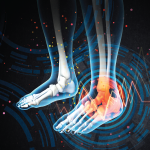At baseline, patients in the half-dose group on methotrexate monotherapy received a median of 19.5 mg of methotrexate per week, and patients in the stable-dose group received a median of 19.0 mg of methotrexate per week. In the half-dose group, the csDMARD treatment was reduced to a half dose at the baseline visit (e.g., 25 mg of methotrexate taken once per week was changed to 12.5 mg of methotrexate taken once per week). If a patient in the half-dose group used a combination of csDMARDs, each csDMARD was reduced by half.
The investigators defined flares as a combination of Disease Activity Score (DAS) greater than 1.6, which is the threshold for RA remission; an increase in DAS score of 0.6 units or more; and at least two swollen joints. The researchers also recorded a disease flare if the patient and investigator agreed a clinically significant flare had occurred. Dr. Meysami notes, this latter approach to diagnosing flares is more common in Europe than in the U.S.
Gradual Tapering an Option
During the 12 months of the study, 19 patients (25%) in the half-dose group experienced a disease flare, as did five (6%) in the stable-dose group (risk difference: 18%; 95% confidence interval, 7–29%]). However, Dr. Meysami notes that because the study was open label, physicians may have been more likely to worry about patients taking a half dose than those taking a full dose. Thus, they may have been more likely to document a flare in those patients. In the paper, the authors acknowledge this limitation, but emphasize that study investigators and nurses were repeatedly instructed about the importance of capturing flare outcomes in both groups.
Dr. Meysami also notes the study called for an abrupt switch from the full to half dose. In his practice, he is more likely to taper the medication dose gradually, monitoring to see if the patient tolerates the lower dose. According to Dr. Meysami, this paper suggests a gradual taper may be more beneficial than an abrupt reduction of the csDMARD dose.
Lara C. Pullen, PhD, is a medical writer based in the Chicago area.
References
- Lillegraven S, Sundlisæter NP, Aga AB, et al. Effect of half-dose vs. stable-dose conventional synthetic disease-modifying antirheumatic drugs on disease flares in patients with rheumatoid arthritis in remission: The ARCTIC REWIND randomized clinical trial. JAMA. 2021 May 4:325(17):1755–1764.
- Fraenkel L, Bathon JM, England BR, et al. 2021 American College of Rheumatology guideline for the treatment of rheumatoid arthritis. 2021. Arthritis Rheumatol. 2021 Jul;73(7):1108–1123.
- Smolen JS, Landewé RBM, Bijlsma JWJ, et al. EULAR recommendations for the management of rheumatoid arthritis with synthetic and biological disease-modifying antirheumatic drugs: 2019 update. Ann Rheum Dis. 2020 Jun;79(6):685–699.
- van Mulligen E, de Jong PHP, Kuijper TM, et al. Gradual tapering TNF inhibitors versus conventional synthetic DMARDs after achieving controlled disease in patients with rheumatoid arthritis: First-year results of the randomised controlled TARA study. Ann Rheum Dis. 2019 Jun;78(6):746–753.


